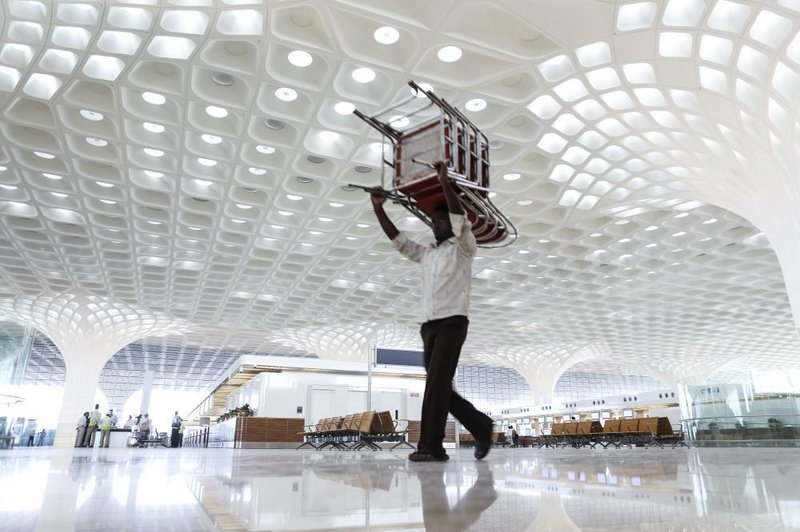MUMBAI, India - India’s overcrowded financial capital unveiled its long-awaited $2 billion new airport terminal on Friday, an ambitious, art-filled space that developers hope will be a showcase success in a country struggling to modernize inadequate infrastructure that is holding back economic growth.
Hemmed in by Mumbai’s sprawling slums, the renovated Chhatrapati Shivaji International Airport was delayed for nearly two years and overran its construction budget by 25 percent. The project was dogged by political disputes, regulatory snarls and difficulty reclaiming more than 300 acres near the runway occupied by tens of thousands of squatters.
“Most people, if not all, wrote it off,” acknowledged Sanjay Reddy, vice chairman of India’s GVK Group, which leads the public-private venture that developed the airport. He said the project will show that India can produce world-class facilities “and not only can we do it, we can doit better.”
The finished terminal has a sleek and airy design, abundant greenery and some 7,000 pieces of Indian art.
The artworks - some of them centuries-old artifacts and others by up-and-coming contemporary artists - are the centerpiece of the terminal, embedded in a 1.9-mile long internal wall that runs along the departure and arrival gates of the four-story building. The check-in facility has a gleaming-white, 11-acre roof with dozens of skylights that resemble the plumage of a peacock, India’s national bird. The 700,000-square-foot retail and gateway areas feature more than 1,000 lotus flower-shaped chandeliers.
Aiming high, Mumbai International Airport Ltd. has declared that the facility, dedicated Friday evening by Prime Minister Manmohan Singh, will be “one of the best airports in the world that consistently delights the passengers.”
For those accustomed to Mumbai’s less-than-delightful current international terminal, where the main escalator to departures has been broken for months, the upgrade is likely to seem dramatic. The airport will shift all international carriers to the new terminal within a few weeks and hopes that most domestic airlines will operate from a lower level in the same building in about a year after it demolishes the current terminal and finishes the fourth leg of the new, X-shaped building.
The difficulties of the project in India’s largest metropolitan area of 21 million people - an estimated 60 percent of whom live in its vast slums- have mirrored many of the problems the country faces in building the new roads, power plants and other projects necessary to ease choke points that have contributed to a sharp slowdown in economic growth.
“It’s an absolute microcosm, representing practically every challenge facing development of Indian infrastructure,” said Amber Dubey, an infrastructure expert for KPMG. Problems included a protracted political battle over moving a statue of the 17th-century Hindu warrior king after which the facility is named. The airport operator eventually agreed to install another statue and a museum to Shivaji nearby.
About 300 acres at the airport is taken up by a vast shantytown overlooking the runway, housing about 75,000 people. It is part of a wider slum of about 200,000 people surrounding the airport. So far the airport operator says it has relocated only about 100 families, and the inaccessible land is blocking its plans to finish the new terminal and also regain its huge investment by developing commercial space around the facility.
Slum dwellers say they shouldn’t have to move, arguing that many who built their modest dwellings by hand have been there for decades and are demanding compensation or new houses elsewhere.
“Making new airports won’t solve the problems of the poor,” said Sachin Chandrakant Nimbalkar, a dockworker who lives in a 10-by-20 foot concrete room with seven family members and no indoor toilet.
While the project stalled over the disputes, Mumbai, formerly known as Bombay, lost its longtime status as India’s busiest airport to the national capital, New Delhi, where another newly constructed terminal had some 34 million passengers last year versus Mumbai’s 30 million. The terminal was built under the country’s airport privatization program that began in 2006.
Still, the new Mumbai terminal could soon be overwhelmed by India’s fast-growing demand for air travel. Its annual capacity of 40 million passengers, up from about 30 million now, is likely to be reached within just five years.
“Mumbai’s development will choke without an expansion of airport capacity,” said KPMG’s Dubey. “The economy cannot move unless you have good roads, ports, highways, railways and airports.”
Business, Pages 27 on 01/11/2014
